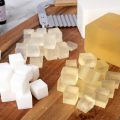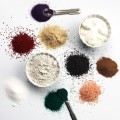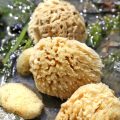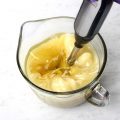Anne-Marie Note: This is a guest blog post by Alesia Lau, one of our fantastic instructors and soapsters extraordinaire at Otion – The Soap Bar. Alesia loves to explore the world of color and in her job at Otion, she gets to play with color every day! Taking this class in Bellingham was a natural extension of her desire to learn more about natural colorant options for soap. I’m excited to see her work in some of these great ideas in her upcoming soapmaking experiments.
- Here is some fun terminology: “Weight of Goods” or “WOG,” is your recipe. Basically, xgrams=dye for y grams=cloth. So you would weigh your dry cloth in grams and, depending on what kind of dye you are using, your grams of dye would change. It is similar to a lye calculator. Of course, Sandra has all of these ratios stored in her brain; I would suggest you google the ratio or invest in the Natural Dye Instruction Booklet, which is available through Eaurthues.
- Another piece of terminology is “Light-Fast.” This means, “How will my dye hold up?” “How long will it stay true?” You want something that will retain its color longer. You want something that hold its color under the sun and stress.
The length of time and number of dips all play a role in the outcome of your colors. It’s easy to have a beautiful array of hues with just one color batch!
Now it is time to get to the fun stuff! Let’s go over the interesting dyes we created and used.
Onion Skins- This creates a beautiful golden yellow (normally) but we must have used some magic onions because came up with a gorgeous orange! All we did was cook some onion skins at a rolling boil for thirty minutes.
Weld-Very bright yellow, will make a lovely green when mixed with Indigo. most light fast yellow you will find, for this plant you use the whole plant, and the great thing is weld can be found and grown right here in WA. But be careful, it will try to take over your garden. Weld should be soaked for a few days in water and then boiled for thirty minutes.
Cochineal- This was by far my favorite! This beautiful purple-red, is actually created form a parasitic bug! This color was thought to be made from grain for hundreds of years, in fact only the Pope was allowed to wear this sacred color. Come to find out, it is a cacti-dwelling parasite! This we also boiled for thirty minutes, but because this is not made from plant material, you can re use the dye, without fear of mold.
Madder Root- This will make a lovely red-orange. It loves hard water, so for us up in the Pacific Northwest, you should add calcium carbonate to your water prior to boiling. This will ensure that your madder does not just turn brown and instead gives you that lovely, unique hue. You also need to make sure that your dye never reaches a temperature of 155F or higher and cook for 30 minutes.
Indigo- Holy Buckets! The art of indigo dyeing is a mix of religion, chemistry, patience, love, lore, tradition and gumption! Every civilization has its own unique blend for indigo, and each blend comes from wildly different sources. There is no specific indigo plant. This hue is collected from the tannins of plants. I highly recommend seeking out Sandra if you are interested in this divine colorant. Fortunately for the soapies in the group, we can just buy a powdered colorant to achieve the glorious blue.
Here are four pieces of cloth per color combination; Fine silk, silk, cotton, and linen. The dyes used are (top row, left to right) indigo, weld, cochineal, (bottom, left to right) indigo and weld, weld, madder, and cochineal with indigo.
Before we could dye our scarves and socks though, we had to make sure that our material had been through a scouring, and mordanting process; which can take weeks and a lot of know-how. Luckily, you can buy cloth that is ready to dye so you can get right to the coloring.
We had our cloth soaking in the dye for a few hours, some of the dyes were still on a low temperature; every dye has its own secret to success. After we felt that our cloth was done we rinsed and washed them in the tub and hung the items to dry; Remember your piece will always dry a few shades lighter.
Using creative techniques, you can make new pattern discoveries.
Fun Facts About Dyeing
• You can use fresh OR dried medium! Drying your plant makes for year round dyeing.
• You can make a deeper color by using less water or more plant material.
• When dyeing cloth every “dip” makes for a deeper shade.
• Your colors will change based on what material you are coloring, protein fiber vs. cellulose fiber.
• A protein fiber is anything that comes from an animal; silk, sheep wool, alpaca, mohair are all protein fibers.
• A cellulose fiber is anything that comes from a plant; cotton, linen, hemp, rayon, tencel.









Hello! According to my wonderful instructor, plants used to make indigo dye vary from country to country. it is not actually one specific plant but a tannin that is common in many plants to make the beautiful blue. I hope this was helpful sometimes my brain doesn’t like to work with the keyboard 🙂
Alesia~Otion
This looks like it was a lot of fun! I love all the colors. I do lots of fabric dying around Halloween for my costume, I will have to keep this info in mind and give it a try.
Wow so neat! Kind-of reminds me of dipping candles, the more dips the darker the shade. Same w/ tie-dyeing. 🙂 Cool stripey design on the scarf, btw.
~Nickie~
Great information but I was surprised at your statement that there is no specific indigo plant. I was on Daufuskie Island, off the cost of S. Carolina, this summer and the indigo plant (indigofera tinctoria) was once cultivated there for indigo dye. There are still indigo plants on the island. (I was even given a leaf which when I allowed it to dry turned an indigo color.) Here is the link to wikipedia article on indigoferea tinctoria: http://en.wikipedia.org/wiki/Indigofera_tinctoria
Nevertheless, I enjoyed this blog on natural dyes – as I enjoy all your very informative and helpful blogs – and Bramble Berry products.
I’m not sure what Alesia meant by that comment. I’ve read it a few times and it’s not clear if she actually is saying that there are a variety of types of “indigo plants” that are all different depending on the region (which matches up with your thoughts) or if she’s saying something else. I’ll pass along to her to clarify! =)
Thanks for sharing, trying the blue – looks fantastic !! I don’t see it listed as one of your products. 8(
We’re looking for one that is cosmetic-grade. Would love to add it to the line =)